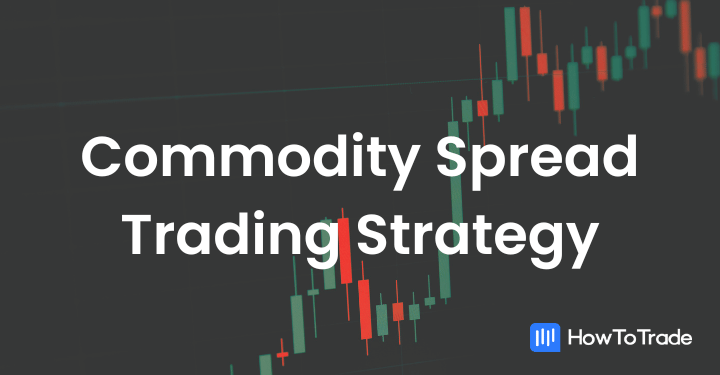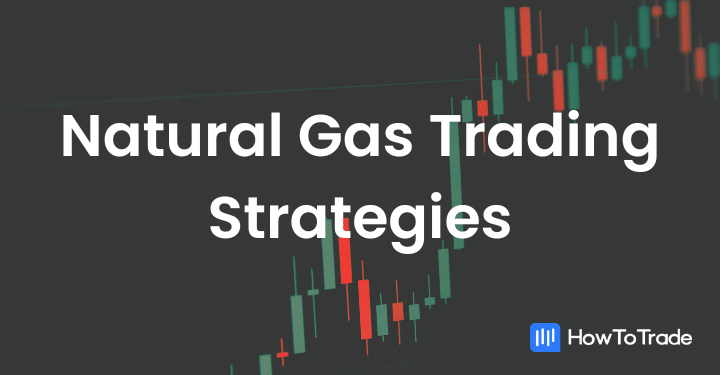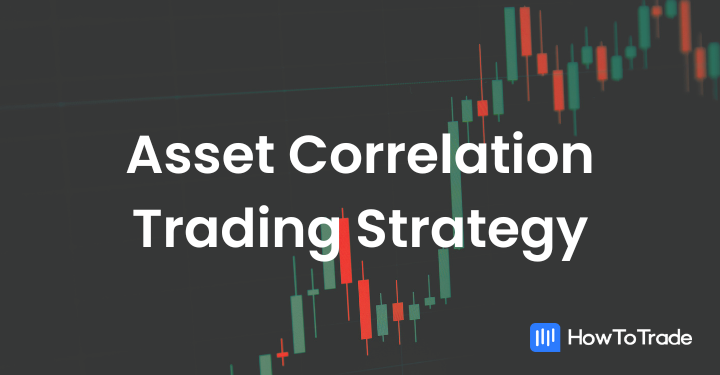
- In trading, gaps are blank areas on a price chart that usually tend to get filled.
- There are four types of price gaps – common, breakaway, continuation, and exhaustion.
- Gaps typically occur when the market opens or due to unexpected fundamental and technical events.
- Since price gaps tend to get filled, professional traders use these blank areas to find trading opportunities.
Let me tell you something. Professional traders love gaps in the markets! That’s a fact. Any sort of gap, you name it, is an opportunity for a good trade. I can still remember from my days as a commodity prop trader how someone shouted almost every day, “wait for the gap to get filled,” immediately after the market opened. Price gaps are something you simply cannot ignore.
And there are many ways to trade gaps. For example, some traders love to enter a trade with the expectation that the gap will get filled, meaning in the opposite direction of the gap, while others simply wait for the gap to get filled before they make any trade. Or, you can enter in the same direction as the gap.
The catch – yes, gaps usually tend to get filled, but when? It could happen immediately, but it can also happen tomorrow, or who knows when? Either way, trading gaps is one of the most simple and effective trading techniques. And here, we are going to talk about the price-gapping trading strategy.
 Table of Contents
Table of Contents
What is a Gap in Trading?
So, what is the gap in trading? Let’s use a simple example. You go to the market and buy apples at a price of $1 per kilogram. The next day, the cost of Apples in the same market rose slightly to $1.1 per kilogram. Now, that’s a gap. Simple as that.
The good thing is that in trading, you can use this gap to find profitable trades. Unlike off-the-market products, instruments traded in financial markets are viewed in different timeframes on price charts. Price gaps are simply areas on a price chart where there’s no trading activity, and the asset’s price either rises or falls from the previous candle’s closing price. This can be a week, day, 1-Hour, or any other time frame.
Obviously, gaps are less common in markets that trade around the clock, like the forex or cryptocurrency market. Still, it could happen, especially during economic data releases and unexpected news that may drastically impact the market. On the other hand, price gaps are extremely common in the stock and futures markets, where the market opens and closes every day.
So, enough talking for now. Let’s see an example of a price gap on a chart.

As you can see in the Tesla daily chart above, price gaps occur quite frequently. And in most cases, they also get filled at some point. Having said that, a quick look at the chart above shows that there’s no one right way to trade gaps. For instance, in the first price gap, the price covered the gap and continued trading higher in the same direction. On the other hand, in the second and third scenarios, once the price gap was filled, the market reversed.
This means that price gaps should always be traded in context with the market’s trend and sentiment. You need to closely watch where the market is heading immediately after the gap and, based on that, take the appropriate trading gap strategy.
Why Does a Price Gap Occur?
Typically, a gap occurs when a market opens at a higher or lower price than the previous closing price. It could be on any timeframe; however, gaps are mostly linked to daily charts.
Now, apart from the cryptocurrency market, all other markets have opening and closing times. The forex market, for instance, is open 24/5 and is closed on Saturday and Sunday. Therefore, in forex trading, traders can find price gaps when the market opens on Monday.
But gaps are mostly common in markets with opening and closing hours. Most stock markets, as well as futures exchanges around the world, are open for 8-9 hours a day. This leaves plenty of time for unexpected events to influence assets’ prices when the markets are closed. Then, when the market reopens, a fundamental factor that was released is being priced in, and gaps occur when a financial instrument opens at a lower or a higher price than the previous day.
As a matter of fact, central banks and private companies often prefer to release important data at times when the markets are closed (They usually do that to reduce volatility and market noise). Eventually, these unexpected events, such as earnings reports, economic data, and political issues, may create a gap in the market.
Bear in mind that a gap can also occur when you are holding a position overnight. Therefore, it is also crucial to closely follow the economic calendar, companies earning results, and commodities reports. Additionally, while gaps are mostly defined by an area with no trading activity, some types of gaps, like the Fair Value gap, have different patterns and are not formed with a blank area on a price chart.
So, all things considered, gaps are usually created by fundamental underlying factors, especially in the stock market. In the foreign exchange market and the crypto market, finding gaps is rare as these markets run 24 hours, five days a week. However, in some cases, you can identify a gap in specific currency pairs on Sunday/Monday when the market opens or during the day when economic data is released.
4 Different Types of Price Gaps
There are four types of price gaps that can appear on a price chart. Those include:
1. Common Gaps
A common gap, also known as an area gap, is a price gap that occurs without any pattern or shape. Typically, these gaps happen due to technical reasons and, in most cases, tend to get filled quickly.
2. Runaway Gaps
As the name implies, runaway/continuation gaps usually occur in the middle of a price trend and indicate that the trend is expected to continue. When a continuation gap is identified, it means that the trend is very likely to continue. A runaway gap is also characterized by a significant gap and high volume in the market.
3. Breakaway Gaps
A breakaway gap is an untraded region that occurs at the end of a trend or, more accurately, at the end of a period when the market is in consolidation. Usually, it marks the end of the previous sideways region and the beginning of a new trend. Generally, breakaway gaps are less likely to get filled; if they do, it usually takes a long time for the gap to be filled.
4. Exhaustion Gaps
An exhaustion gap typically occurs at the end of a long market trend when asset prices are testing new record highs or lows. As a result, this type of price gap signals a taking profit condition and a reversal of the prior trend.
Price gaps should always be traded in context with the market’s trend and sentiment. You need to closely watch where the market is heading immediately after the gap and, based on that, take the appropriate trading gap strategy.
Gap Trading Strategies – Ways to Trade Price Gaps
Essentially, there are three common ways to trade price gaps. Either you trade the gap, meaning you are entering a trade with the expectation that the gap will likely be filled, or you wait for the gap to get filled before entering the market. Another strategy, known as the gap and go, involves buying or selling an asset with the assumption that the price will continue to move in the direction of the gap.
With that in mind, let’s quickly review each of the three price gap trading strategies:
1. Trade the Gap
The most common way to trade a gap is to… trade the gap. What does it mean? Well, when you trade the gap, you basically enter a position when the market opens higher or lower from the previous close, expecting the market to close the gap. According to this technique, the gap is likely to get filled, and you are trying to exploit this opportunity.
For example, if the market gaps up when it opens, you immediately enter a short-sell position and close it when the gap gets filled.
Let’s see an example:
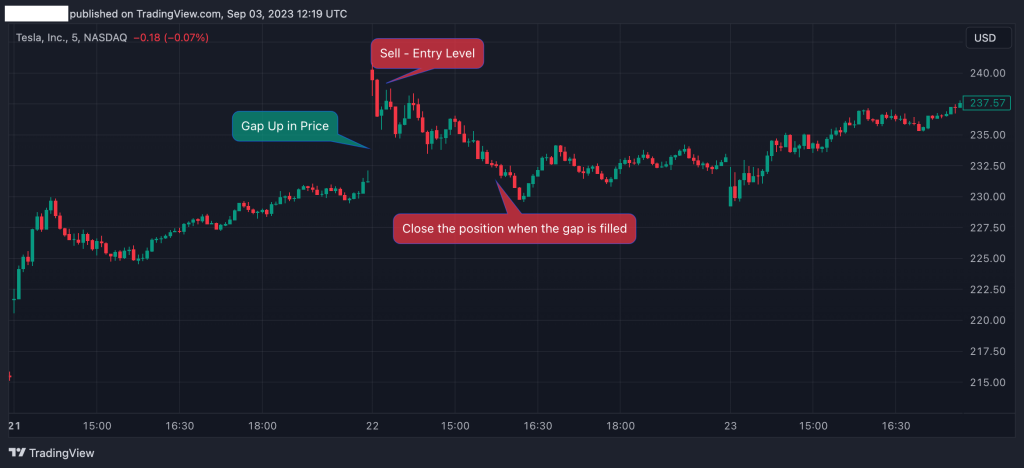
As shown in Tesla’s 5-Min chart above, the price gapped up at the open. Then, as soon as the first candle closes and the price pushes toward closing the gap, you should enter a short-sell position. You can then close your position when the gap is filled or wait to see if it breaks further below the previous closing price.
Note, however, that you must pay close attention to the market’s sentiment following the price gap. You should utilize this strategy if the market moves toward closing the gap; however, if it opens with a gap and continues in the gap’s direction, then you might wait for another opportunity when the price is about to close the gap.
One tip that might be helpful. From my experience, in the vast majority of cases, when the asset starts filling the gap, the price will go down until the point it fills the entire region. This is something you should take into your decision process and use as much as possible.
2. Wait for the Market to Close the Gap and Enter a Position
Another way to trade gaps is to wait for the gap to be filled before entering the market. Honestly, trading gaps can be quite an intimidating scenario since there’s high volume and the market’s volatility is high. Therefore, not all traders have the skills or the nerves to enter the market when it’s choppy and risky. The solution is to wait for the noise to disappear before making any trading decision.

In this example, you can see how the market reacts when the price opens with a gap down. Indeed, the gap is filled, and you could have taken a profit here by taking a position in the opposite gap direction.
However, as mentioned, the markets tend to be very choppy when there is a price gap, and often, it is advisable to wait for the gap to get filled before you make any trade. If this is the case, then you should wait until the market is less volatile and take a trade when you can clearly see where it’s heading.
Note that if the market gaps up or down and rises or falls below the opening price, then you get a solid signal to enter a trade. So, using the example above, you can see how the market is gapping down and breaking below the opening price. When this happens, the market typically continues in this direction, as the factor that created the gap appears to be insignificant.
3. Gap and Go Strategy
The gap and go is one of the most popular trading strategies you can find. Technically, most traders who utilize this technique use pre-market scanners or pre-market gappers and focus on the first hour, or even less than that, following the market’s opening.
Essentially, the gap and go is a continuation momentum-based trading strategy in which a trader buys or sells the asset in the same direction as the gap. For instance, let’s say the market gap is up by 3% when the bell rings, and the buying pressure continues in the first minutes following the opening. So, based on the gap-and-go strategy, you’ll enter a long buying position to ride the bullish momentum.
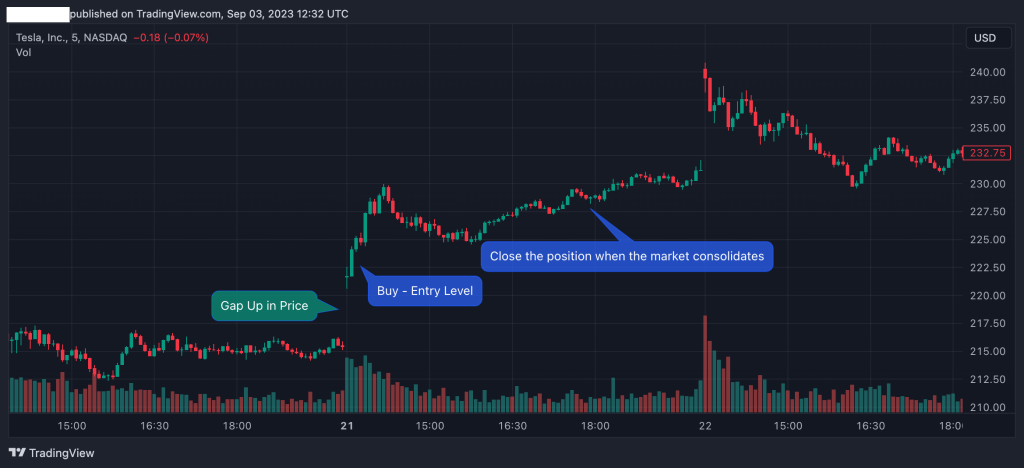
In the above example, Tesla’s stock price gapped following the pre-market session. However, this time, the price continued rising with high trading volume at the opening.
This market scenario provides a strong signal that something significant has happened, and the news is likely to have a strong impact on the asset’s price. Therefore, in this situation, you can apply the gap-and-go strategy, meaning you should join the trend and enter a position in the direction of the gap.
Learn How to Master the Gap Trading Strategy with HowToTrade
To sum up, trading gaps is a great strategy that can be highly profitable if well mastered. Generally, gaps are not always filled. Occasionally, it may take days, weeks, and even months until the gap is filled. However, I don’t think I’ve seen many cases in which a price gap was not filled (unless the asset is illiquid and there’s low volume). So, adding this ‘trick’ to your tool kit and applying it to your trading routine could be extremely useful.
If you are keen to learn more about the gap trading strategy, along with many other trading strategies, we suggest you join our trading academy. You can also check our trading tools, and trading coaching from our experienced trading mentors.
Frequently Asked Questions About Gap Trading
Here are the most frequently asked questions about the gap trading strategy:
How to trade gaps successfully?
Frankly, trading gaps might be a tricky business. While spotting gaps does not require special trading skills, learning how to trade them could be quite a challenge. Still, if you master your skills in this area, gap trading offers many opportunities.
To trade gaps successfully, you must first learn how the market reacts when it’s gapping. Additionally, you can integrate other trading tools, such as technical indicators and chart patterns to increase the chances of success. Ultimately, it’s a trial and error process, and it might take some time before you know how to master this strategy.
Is trading gaps profitable?
Yes, trading gaps can undoubtedly be a profitable strategy. However, before you decide to use this strategy, you must backtest your trading strategy and realize whether it is the right one for you. On that note, remember that some traders prefer to avoid volatile markets, which is usually the case with the gap trading strategy.
Which market is the best to trade gaps?
Logically, the best markets to trade gaps are those with opening and closing hours. Those include the stock market, futures, and options. This way, you can use a pre-market scanner to find gaps and utilize this strategy for the first 30 minutes to 1 hour following the opening.
How to trade stock gaps?
As we mentioned in our guide, price gaps are more common in the stock market than in other markets, mainly because the stock markets are open for several hours a day. To trade stock gaps, you must watch the pre-market and utilize the gap strategy in the first hour after the stock market opens. Once you identify a price gap, wait for the next candle to be completed and try to identify the type of gap. Whenever the stock’s price starts filling the gap, this is your trade – meaning you need to stay until in a trade it covers the entire gap. Or, if the price moves in the direction of the gap, then you should use the gap-and-go strategy.
Additionally, one of the key things that create gaps in the stock markets is earnings reports and economic data, so it is advisable always to be alert to reports released by public companies and economic data released by central banks.
Risk Disclosure: The information provided in this article is not intended to give financial advice, recommend investments, guarantee profits, or shield you from losses. Our content is only for informational purposes and to help you understand the risks and complexity of these markets by providing objective analysis. Before trading, carefully consider your experience, financial goals, and risk tolerance. Trading involves significant potential for financial loss and isn't suitable for everyone.


